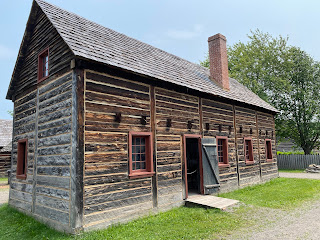This is a well-maintained privately owned park in Thunder Bay, Ontario. There are two sides to the Park. First is a recreation of For William, which it turns out was never located in this location. Meticulous drawings of the fort were made, however, and the recreation is said (by guides) to be accurate. So no Disney-like modified recreation here, right? Just facts. (Note, however, that there are actors in period costumes who attempt to speak in fake 1810s accents.) The second side of the Park is a concert area. When we visited the venue was beginning a weekend-long Country Western Festival, Country on the Bay, July 19-21. Blake Shelton, Dallas Smith, Trace Adkins were slated to be there. The festival was interesting because they split into two halves—one for drinkers and one for teetotalers. Nice idea. Capacity was 12,000 a day. Three-day pack was $366.12.
Back to the Fort, though, which was interesting as a prototype of a trading spot. Fort William was named for William McGillivray, chief director of the North West Company between 1804 and 1821. The fort was not actually built for defensive purposes—the only attacks would be from the U.S. By 1815 the local Anishinaabeg would have been pretty tamed. This subgroup was of Anemic Wajiw, Thunder Mountain. Most of the Anishinaabeg around Lake Superior were Ojibwa.
There is an Indian encampment near the fort, by the river. The guides also noted that a Métis village would have been located across the river also. There was also a spot where visiting traders pitched their tents. There were several long canoes illustrating the vessels the traders probably used. We also saw how the pelts were bundled into standard size cubes just light enough for one man to carry with a strap around his forehead. Each trapper was said to take two bales in his canoe—any more and he would not have been able to carry things over the rapids between Thunder Bay and Montreal.
The Great Hall sits at the center of the fort. Around this are yards for canoe making, blacksmithing, and living. There was also an agricultural field. There were quarters for a few—the head of the fort and family and a ship’s captain. But the population of the fort was very low during the winter. The Anishinaabeg probably wintered in locations to the south with more game.
Fort William was one of many trading posts in the Great Lakes region. The largest were probably Michilimackinac and Detroit, besides Montreal. This visit opened my eyes to the trading networks that criss-crossed this region, and to the mixing of French, British, American and Anishinaabeg that characterized most of its early history. The original Fort William, and the city of Thunder Bay today, is built on land leased from the Anishinaabeg.




No comments:
Post a Comment